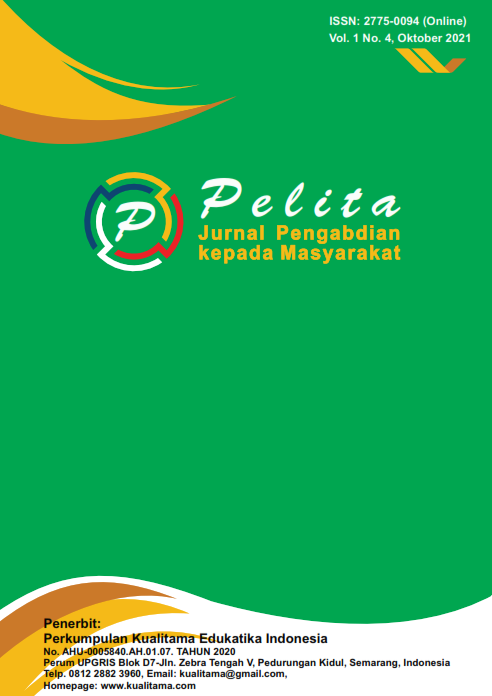Pelatihan dan Monitoring Pemanfaatan Literasi Media Digital di Masa Pandemi Covid 19 bagi Guru di Gugus 2 Kecamatan Pagelaran Kabupaten Malang
Main Article Content
Abstract
Digital media literacy and monitoring the use of digital media and online media during the COVID-19 pandemic are currently widely accessed by the general public, but many students during the current pandemic are not able to use digital media intelligently. The objectives of this community service activity include: 1) providing education and socialization to teachers and parents about the characteristics of digital media accessed by children during the COVID-19 pandemic, 2) providing knowledge about the impact of using digital media on behavior and development. psychology of children, 3) provide encouragement to teachers and parents to be able to provide assistance to children in managing the use of digital media intelligently. This type of service design is socialization and case studies as well as the method in carrying out this activity using the question and answer method of training, lectures, discussions, and case simulations about the use of gadgets that are good and right. The method used in community service is through seminar kits and workshops. With these trainings and workshops, it is hoped that there will be two-way communication, both between resource persons and participants and between participants themselves. The results of the training activities during mentoring for approximately 1 month are: 1) teachers are more interactive when teaching online in packaging learning using applications that are synchronized with online media such as zoom meetings, google meetings and group watzhap. 2) Parents and teachers are increasingly understanding about the characteristics of digital media, 3) teachers and parents are increasingly understanding about the impact of using digital media on children's behavior and psychological development, 4) parents are increasingly effective in assisting children in regulating intelligent use of digital media anytime and anywhere, 5) there is a very big influence that students are motivated to be enthusiastic in learning because during this pandemic there is a scale of restrictions in learning, 6) There is awareness of parents in preparing financially to buy learning quota packages maximum.
Article Details
References
Erstad, O. (2012). The Learning lives of Digital Youth – Beyond The Formal And Informal. Oxford Review of Education, 38 (1), h. 25-43. http://dx.doi.org/10.1080/03054985.2011.577940.
Fatmawati N. (2019). Literasi Digital, Mendidik Anak Di Era Digital Bagi Orang Tua Milenial. Madani Jurnal Politik Dan Sosial Kemasyarakatan, 11(2), 119–138.
Furlong, J., & Davies, C. (2012). Young People, New Technologies and Learning at home: taking context seriously. Oxford Review of Education, 38 (1), h. 45-62. http://dx.doi.org/10.1080/03054985.2011.577944.
Friesem, Y. (2019). Teaching Truth, Lies, and Accuracy in the Digital Age: Media Literacy as Project-Based Learning. Journalism and Mass Communication Educator, 74(2), 185–198. https://doi.org/10.1177/1077695819829962.
Hartati, N. S., Thahir, A., & Fauzan, A. (2019). Manajemen Program Penguatan Pendidikan Karakter Melalui Pembelajaran Daring dan Luring di Masa Pandemi Covid 19-New Norma. Journal of Chemical Information and Modeling, 53(9), 1689–1699.
Hadayani, D. O., Delinah, & Nurlina. (2020). Membangun Karakter Siswa Melalui Literasi Digital Dalam Menghadapi Pendidikan Abad 21 (Revolusi Industri 4.0). Prosiding Seminar Nasional Pendidikan Program Pascasarjana Universitas PGRI Palembang, 21, 999–1015.
Miller, L., Musci, R., D’Agati, D., Alfes, C., Beaudry, M. B., Swartz, K., & Wilcox, H. (2019). Teacher Mental Health Literacy is Associated with Student Literacy in the Adolescent Depression Awareness Program. School Mental Health, 11(2), 357–363. https://doi.org/10.1007/s12310-018-9281-4.
Potter, W. J. (2010). The State of Media Literacy. Journal of Broadcasting & Electronic Media, 54 (4), h. 675-696. http://dx.doi.org/10.1080/08838151.2011.521462.
Pfaff-Rüdiger, S., & Riesmeyer, C. (2016). Moved into Action. Media Literacy As Social Process. Journal of Children and Media, 10(2), 164–172. https://doi.org/10.1080/17482798.2015.1127838
Reyna, J., Hanham, J., & Meier, P. C. (2018). A framework For Digital Media Literacies For Teaching and Learning in Higher Education. E-Learning and Digital Media, 15(4), 176–190. https://doi.org/10.1177/2042753018784952.
Rogers, A. (2017). Global Media Literacy In A digital Age: Teaching Beyond Borders. International Review of Education, 63(1), 137–139. https://doi.org/10.1007/s11159-016-9600-7
Sekarasih, L., Walsh McDermott, K., O’Malley, D., Olson, C., & Scharrer, E. (2016). To Guide or To Be the sage: Children’s Responses to Varying Facilitator Prompts Following a Media Literacy Education Curriculum in the United States. Journal of Children and Media, 10(3), 369–384. https://doi.org/10.1080/17482798.2016.1157503
Talib, S. (2018). Social Media Pedagogy: Applying An Interdisciplinary Approach To Teach Multimodal Critical Digital Literacy. E-Learning and Digital Media, 15(2), 55–66. https://doi.org/10.1177/2042753018756904.
Wei, Y., Hayden, J. A., Kutcher, S., Zygmunt, A., & McGrath, P. (2013). The Effectiveness Of School Mental Health Literacy Programs To Address Knowledge, Attitudes And Help Seeking Among Youth. Early Intervention in Psychiatry, 7(2), 109–121. https://doi.org/10.1111/eip.12010.
Yamaguchi, S., Foo, J. C., Nishida, A., Ogawa, S., Togo, F., & Sasaki, T. (2020). Mental Health Literacy Programs For School Teachers: A Systematic Review And Narrative Synthesis. Early Intervention in Psychiatry, 14(1), 14–25. https://doi.org/10.1111/eip.12793
Zillmann, D., Callison, C., & Gibson, R. (2009). Quantitative Media Literacy: Individual Differences in Dealing with Numbers in the News. Media Psychology, 12(4), 394–416. https://doi.org/10.1080/15213260903287275.

